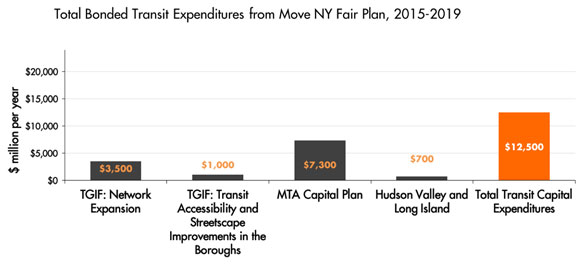
For the first time, a state legislator is sponsoring legislation in Albany to enact the Move NY toll reform plan. By creating a more rational toll system in New York City, the plan would significantly reduce traffic and raise revenue to invest in improving transit.
Assembly Member Robert Rodriguez introduced a bill today, A09633, that would toll the four East River bridges and a cordon across 60th Street in Manhattan while reducing tolls on crossings farther from the city core. Rodriguez represents East Harlem and has agitated for timely completion of phase two of the Second Avenue Subway, which would serve his district.
The new tolls around the Manhattan core would be set at the same rate as the Brooklyn Battery Tunnel and Queens Midtown Tunnel -- currently $5.54 with E-ZPass -- and would be issued without tollbooths. Taxis and for-hire vehicles would be assessed additional fees per mile when traveling in the area of Manhattan below 110th Street on the West Side and 96th Street on the East Side, but would be exempt from the new tolls.
Creating a consistent price to drive into the Manhattan central business district will cut traffic on and around the East River bridges, where motorists currently get a free ride, with congestion-reducing ripple effects throughout the city's street network. Additional revenue from the new toll structure would be plowed into fixing up, modernizing, and expanding the New York region's transit network, and into maintaining the East River bridges.
At a press conference this morning, Rodriguez framed Move NY as a fairer plan than using general state revenue to fill the gap in the MTA capital program. "As legislators, we need to fund the MTA capital plan," he said. "And we will, but we don't have to do it solely on the back of taxpayers who don't have to use the system."
Under the legislation, additional revenue would be divvied up among a few agencies and authorities, with most of it being bonded against and allocated to the MTA:

- The MTA would bond against $487 million in annual revenue to raise $7.3 billion for its five-year capital program, removing the current uncertainty about the state's commitment and ending the possibility that transit riders would pay higher fares in order to cover the gap.
- Another $4.5 billion in bonded revenue would go to a new entity called the Transit Gap Investment Fund that would direct the money largely toward subway and bus network improvements. The legislation spells out a project list -- Second Avenue Subway phase two would be in line for $500 million, Triboro RX would get $1 billion, etc. (see page 7 of the bill summary). A $1 billion chunk would be split up among various transit access, walking, and biking improvements in the five boroughs. The TGIF would have its own board, composed of appointees selected by state and city electeds, that would determine how to spend the money.
- As much as $300 million annually would go directly to maintaining the four East River bridges, and another $75 million would go toward general road maintenance in NYC.
- $700 million in bonding would pay for transit improvements in Long Island, Westchester, and the Hudson Valley.
With the clear need to provide some certainty for the MTA capital plan, this is the big opening for Move NY, which could do more than any other single policy to cut traffic and improve transit in NYC.
The introduction of Rodriguez's bill means we'll soon see if Move NY can muster the political support that Governor Andrew Cuomo has said is lacking.
"I think he's been doubtful or skeptical of the political chances of a plan like this and I think by doing so he's made it clear, 'Show me a political path and maybe I'll be on board,'" Move NY's Alex Matthiessen said of Cuomo. "He's had many many opportunities to walk away from this in a very definitive way, and he hasn't done that. He understands, like the rest of us, that we need a new source of sustainable revenue for our transit system, and I think he's hoping some good plan comes along."
The City Council won't be voting on this bill, but its Progressive Caucus has endorsed Move NY. The Assembly bill currently has 14 co-sponsors, according to Crain's. In addition to picking up more sponsors in the Assembly, the next piece to fill in would be a New York City Republican to sponsor the bill in the State Senate.
Move NY has a handy form to contact your representatives in Albany to support the plan.
Updated at 2:00 p.m. to include quotes from Robert Rodriguez and Alex Matthiessen. David Meyer contributed reporting to this post.





